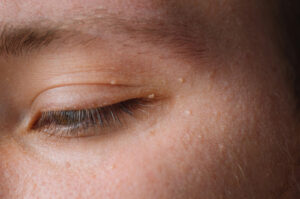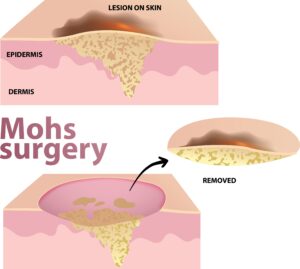Eyelid lesions are very common and can range in severity from benign to malignant. At The Medical Eye Center in Manchester, Nashua, and Bedford, New Hampshire, Dr. Slentz is a board-certified oculofacial surgeon who can help treat many types of skin lesions around the eyes.

An eyelid lesion is a growth that forms over time and can be on either your lower or upper eyelids. These growths can form rapidly or slowly and can vary in size, shape, and color.
Eyelid lesions can be simple benign (noncancerous) growths, or, in some cases, they can be malignant (cancerous). Besides possibly being malignant, eyelid lesions can also be a cosmetic nuisance.
Some people are more concerned than others about the cosmetic appearance of eyelid lesions. If the cosmetic appearance does not bother you, if you have noticed a new lesion or one that is changing in size, shape, or color, it is best to get it looked at by a professional.
Dr. Slentz has the experience and knowledge to monitor these lesions and treat them if necessary.
Eyelid lesions are very common and are often benign. However, it is essential to monitor your lesions and watch for any changes.
Benign lesions will often not cause any irritation or be bothersome to you unless cosmetically. They are usually flesh-colored or may resemble a mole.
Malignant lesions can be brown, black, red, or your skin’s normal color. You may also notice that these lesions have difficulty healing.
Some other common signs and symptoms of malignant eyelid lesions are:
If you notice a new lesion on your eyelid with any of these characteristics, it’s best to have your oculofacial surgeon look at it. If they are concerned that it may be malignant, they will send it for a biopsy.
Dr. Slentz can easily remove eyelid lesions during a quick, in-office procedure. Before the procedure, you will need to schedule an initial consultation first to determine the kind of lesion and the best treatment for it. Removing eyelid lesions is a simple procedure for necessity or cosmetic purposes.
If your lesion is benign or not bothersome to you, your oculofacial surgeon may tell you that it does not need to be removed. If your lesion hinders your vision or other functions of your eyes or eyelids, it may be necessary to have it removed.
Your eye doctor will use a local anesthetic to numb the area to remove eyelid lesions. After removing the lesion, they may send it for a biopsy.
Depending on the size and location of the lesion, you may or may not need stitches. Your oculofacial surgeon may put ointment on the area, and you will go home the same day.
These areas tend to heal easily and on their own without additional treatment. Depending on the type of lesion, it may grow back in some cases.
Oculofacial surgeons are very familiar with the skin around the eyes. Due to this, dermatologists often send their patients to see oculofacial surgeons for further evaluation of lesions they believe to be cancerous.

Mohs surgery is a precise technique used to treat skin cancer on the face. Dr. Slentz will work with your Mohs surgeon during the entire surgery process.
After the Mohs surgeon has removed the entirety of the skin cancer, Dr. Slentz will work to reconstruct the area to improve functionality and appearance. Dr. Slentz is a skilled and experienced oculofacial surgeon who has the knowledge and expertise to accurately diagnose and treat your eyelid lesions.
Are you interested in learning more about how oculofacial surgeons treat eyelid lesions and skin cancer? Schedule an appointment at The Medical Eye Center at one of our convenient locations in Manchester, Nashua, and Bedford, NH, today!